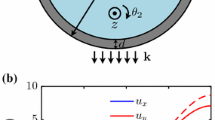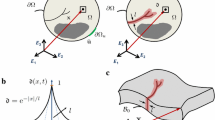Abstract
Micro-electro-mechanical systems (MEMS) made of polycrystalline silicon are widely used in several engineering fields. The fracture properties of polycrystalline silicon directly affect their reliability. The effect of the orientation of grains on the fracture behaviour of polycrystalline silicon is investigated out of the several factors. This is achieved, firstly, by identifying the statistical variation of the fracture strength and critical strain energy release rate, at the nanoscopic scale, over a thin freestanding polycrystalline silicon film having mesoscopic scale dimensions. The fracture stress and strain at the mesoscopic level are found to be closely matching with uniaxial tension experimental results. Secondly, the polycrystalline silicon film is considered at the continuum MEMS scale, and its fracture behaviour is studied by incorporating the nanoscopic scale effect of grain orientation. The entire modelling and simulation of the thin film is achieved by combining the discontinuous Galerkin method and extrinsic cohesive law describing the fracture process.






















Similar content being viewed by others
Notes
These units are modified in the simulation setup to avoid bad conditioning numbers.
References
DelRio FW, Dunn ML, Boyce BL, Corwin AD, De Boer MP (2006) The effect of nanoparticles on rough surface adhesion. J Appl Phys 99(10):104304
Suwito W, Dunn ML, Cunningham SJ, Read DT (1999) Elastic moduli, strength, and fracture initiation at sharp notches in etched single crystal silicon microstructures. J Appl Phys 85(7):3519–3534
Sharpe WN Jr, Turner K, Edwards R (1999) Tensile testing of polysilicon. Exp Mech 39(3):162–170
Sharpe W, Jackson KM, Hemker K, Xie Z (2001) Effect of specimen size on Young’s modulus and fracture strength of polysilicon. Microelectromechanical Syst J 10(3):317–326
Coenen E, Kouznetsova V, Bosco E, Geers M (2012) A multi-scale approach to bridge microscale damage and macroscale failure: a nested computational homogenization-localization framework. Int J Fract 178(1–2):157–178. doi:10.1007/s10704-012-9765-4
Nguyen VP, Lloberas-Valls O, Stroeven M, Sluys LJ (2012) Computational homogenization for multiscale crack modeling. Implementational and computational aspects. Int J Numer Methods Eng 89(2):192–226. doi:10.1002/nme.3237
Mercatoris BCN, Massart TJ (2011) A coupled two-scale computational scheme for the failure of periodic quasi-brittle thin planar shells and its application to masonry. Int J Numer Methods Eng 85(9):1177–1206. doi:10.1002/nme.3018
Belytschko T, Loehnert S, Song JH (2008) Multiscale aggregating discontinuities: a method for circumventing loss of material stability. Int J Numer Methods Eng 73(6):869–894. doi:10.1002/nme.2156
Verhoosel CV, Remmers JJC, Gutiérrez MA, de Borst R (2010) Computational homogenization for adhesive and cohesive failure in quasi-brittle solids. Int J Numer Methods Eng 83(8–9):1155–1179
Tang S, Kopacz A, Keeffe O’ SC, Olson GB, Liu W (2013) Concurrent multiresolution finite element: formulation and algorithmic aspects. Comput Mech 52(6):1265–1279. doi:10.1007/s00466-013-0874-3
Tang S, Kopacz AM, O’ Keeffe SC, Olson GB, Liu WK (2013) Three-dimensional ductile fracture analysis with a hybrid multiresolution approach and microtomography. J Mech Phys Solids 61(11):2108–2124. doi:10.1016/j.jmps.2013.07.007
Kerfriden P, Goury O, Rabczuk T, Bordas S (2013) A partitioned model order reduction approach to rationalise computational expenses in nonlinear fracture mechanics. Comput Methods Appl Mech Eng 256:169–188. doi:10.1016/j.cma.2012.12.004
Holl M, Loehnert S, Wriggers P (2013) An adaptive multiscale method for crack propagation and crackcoalescence. Int J Numer Methods Eng 93(1):23–51. doi:10.1002/nme.4373
Wu L, Tjahjanto D, Becker G, Makradi A, Jèrusalem A, Noels L (2013) A micro-meso-model of intra-laminar fracture in fiber-reinforced composites based on a discontinuous Galerkin/cohesive zone method. Eng Fract Mech 104:162–183
Dugdale DS (1960) Yielding of steel sheets containing slits. J Mech Phys Solids 8(2):100–104
Barenblatt GI (1962) The Mathematical Theory of Equilibrium Cracks in Brittle Fracture. Elsevier, pp. 55–129. doi:10.1016/S0065-2156(08)70121-2
Moës N, Dolbow J, Belytschko T (1999) A finite element method for crack growth without remeshing. Int J Numer Methods Eng 46(1):131–150. doi:10.1002/(SICI)1097-0207(19990910)46:1<131:AID-NME726>3.0.CO;2-J
Moës N, Belytschko T (2002) Extended finite element method for cohesive crack growth. Eng Fract Mech 69(7):813–833. doi:10.1016/S0013-7944(01)00128-X
Armero F, Linder C (2009) Numerical simulation of dynamic fracture using finite elements with embedded discontinuities. Int J Fract 160:119–141. doi:10.1007/s10704-009-9413-9
de Borst R, Gutiérrez MA, Wells GN, Remmers JJC, Askes H (2004) Cohesive-zone models, higher-order continuum theories and reliability methods for computational failure analysis. Int J Numer Methods Eng 60(1):289–315. doi:10.1002/nme.963
Hillerborg A, Modéer M, Petersson PE (1976) Analysis of crack formation and crack growth in concrete by means of fracture mechanics and finite elements. Cement Concrete Res 6(6):773–781
Camacho GT, Ortiz M (1996) Computational modelling of impact damage in brittle materials. Int J Solids Struct 33(20–22):2899–2938
Ortiz M, Pandolfi A (1999) Finite-Deformation Irreversible Cohesive Elements for Three-Dimensional Crack Propagation Analysis. Int J Numer Methods Eng 44(9):1267–1282
Noels L, Radovitzky R (2006) A general discontinuous Galerkin method for finite hyperelasticity. Formulation and numerical applications. Int J Numer Methods Eng 68(1):64–97
Mergheim J, Kuhl E, Steinmann P (2004) A hybrid discontinuous Galerkin/interface method for the computational modelling of failure. Commun Numer Methods Eng 20(7):511–519
Radovitzky R, Seagraves A, Tupek M, Noels L (2011) A scalable 3D fracture and fragmentation algorithm based on a hybrid, discontinuous Galerkin, cohesive element method. Comput Methods Appl Mechanics Eng 200:326–344. doi:10.1016/j.cma.2010.08.014
Becker G, Geuzaine C, Noels L (2011) A one field full discontinuous Galerkin method for Kirchhoff-Love shells applied to fracture mechanics. Comput Methods Appl Mechanics Eng 200(45–46):3223–3241
Becker G, Noels L (2013) A full-discontinuous Galerkin formulation of nonlinear Kirchhoff-Love shells: elasto-plastic finite deformations, parallel computation, and fracture applications. Int J Numer Methods Eng 93(1):80–117
Charles Y (2014) A finite element formulation to model extrinsic interfacial behavior. Finite Elem Anal Design 88:55–66. doi:10.1016/j.finel.2014.05.008
Nguyen VP (2014) Discontinuous Galerkin/extrinsic cohesive zone modeling: Implementation caveats and applications in computational fracture mechanics. Eng Fract Mech 128:37–68. doi:10.1016/j.engfracmech.2014.07.003
Greek S, Ericson F, Johansson S, Fürtsch M, Rump A (1999) Mechanical characterization of thick polysilicon films: Young’s modulus and fracture strength evaluated with microstructures. J Micromech Microeng 9(3):245
Sharpe WN, Yuan B, Vaidyanathan R, Edwards RL (1996) New test structures and techniques for measurement of mechanical properties of MEMS materials. In: Microlithography and Metrology in Micromachining II, Society of Photo-Optical Instrumentation Engineers (SPIE) Conference Series, vol. 2880, Society of Photo-Optical Instrumentation Engineers (SPIE) Conference Series, vol. 2880, pp. 78–91
Van Arsdell W, Brown S (1999) Subcritical crack growth in silicon MEMS. Microelectromechanical Syst J 8(3):319–327
Gravier S, Coulombier M, Safi A, Andre N, Boe A, Raskin JP, Pardoen T (2009) New on-chip nanomechanical testing laboratory—applications to aluminum and polysilicon thin films. Microelectromechanical Syst J 18(3):555–569
Escobedo-Cousin E, Olsen SH, Pardoen T, Bhaskar U, Raskin JP (2011) Experimental observations of surface roughness in uniaxially loaded strained Si microelectromechanical systems-based structures. Appl Phys Lett 99(24):241906
Bhaskar U, Passi V, Houri S, Escobedo-Cousin E, Olsen SH, Pardoen T, Raskin JP (2012) On-chip tensile testing of nanoscale silicon free-standing beams. J Mater Res 27(03):571–579
Passi V, Bhaskar U, Pardoen T, Sodervall U, Nilsson B, Petersson G, Hagberg M, Raskin JP (2012) High-Throughput On-Chip Large Deformation of Silicon Nanoribbons and Nanowires. Microelectromechanical Syst J 21(4):822–829
Ureña F, Olsen SH, Šiller L, Bhaskar U, Pardoen T, Raskin JP (2012) Strain in silicon nanowire beams. J Appl Phys 112(11):114506
Kumar Bhaskar U, Pardoen T, Passi V, Raskin JP (2013) Piezoresistance of nano-scale silicon up to 2 GPa in tension. Appl Phys Lett 102(3):031911–031911-4
Noels L, Radovitzky R (2008) An explicit discontinuous Galerkin method for non-linear solid dynamics: formulation, parallel implementation and scalability properties. Int J Numer Methods Eng 74(9):1393–1420. doi:10.1002/nme.2213
Hulbert GM, Chung J (1996) Explicit time integration algorithms for structural dynamics with optimal numerical dissipation. Comput Methods Appl Mech Eng 137(2):175–188. doi:10.1016/S0045-7825(96)01036-5
Yi T, Li L, Kim CJ (2000) Microscale material testing of single crystalline silicon: process effects on surface morphology and tensile strength. Sens Actuators A 83(1–3):172–178
Sato K, Yoshioka T, Ando T, Shikida M, Kawabata T (1998) Tensile testing of silicon film having different crystallographic orientations carried out on a silicon chip. Sens Actuators A 70(1–2):148–152
Gilman JJ (1960) Direct measurements of the surface energies of crystals. J Appl Phys 31(12):2208–2218
Messmer C, Bilello JC (1981) The surface energy of Si, GaAs, and GaP. J Appl Phys 52(7):4623–4629
Hopcroft M, Nix W, Kenny T (2010) What is the Young’s modulus of silicon? Microelectromechanical Syst J 19(2):229–238
Alzebdeh K, Ostoja-Starzewski M (1996) Micromechanically based stochastic finite elements: length scales and anisotropy. Probab Eng Mech 11(4):205–214
Ostoja-Starzewski M (1998) Random field models of heterogeneous materials. Int J Solids Struct 35(19):2429–2455
Lucas V, Wu L, Arnst M, Jean-Claude G, Paquay S, Nguyen VD, Noels L (2014) Prediction of macroscopic mechanical properties of a polycrystalline microbeam subjected to material uncertainties. In: Cunha A, Caetano E, Ribeiro P, Müller G (eds) Proceedings of the 9th International Conf erence on Structural Dynamics, EURODYN 2014, pp. 2691–2698
Galceran M, Albou A, Renard K, Coulombier M, Jacques P, Godet S (2013) Automatic crystallographic characterization in a transmission electron microscope: applications to twinning induced plasticity steels and al thin films. Microsc Microanal 19(03):693–697
Tsuchiya T, Tabata O, Sakata J, Taga Y, Specimen size effect on tensile strength of surface micromachined polycrystalline silicon thin films. In: Micro Electro Mechanical Systems, 1997. MEMS ’97, Proceedings, IEEE. Tenth Annual International Workshop on (1997), pp. 529–534
Acknowledgments
The authors gratefully acknowledge the financial support from F. R. S. - F. N. R. S. under the project number FRFC 2.4508.11 as well as under the project PDR T.0122.13 “MECANO”. The support of the Belgian Science Policy through the IAP 7/21 project is gratefully acknowledged. Computational resources have been provided by the supercomputing facilities of the “Consortium des Équipements de Calcul Intensif en Fédération Wallonie Bruxelles (CÉCI)” funded by the “Fond de la Recherche Scientifique de Belgique (FRS-FNRS)”.
Author information
Authors and Affiliations
Corresponding author
Rights and permissions
About this article
Cite this article
Mulay, S.S., Becker, G., Vayrette, R. et al. Multiscale modelling framework for the fracture of thin brittle polycrystalline films: application to polysilicon. Comput Mech 55, 73–91 (2015). https://doi.org/10.1007/s00466-014-1083-4
Received:
Accepted:
Published:
Issue Date:
DOI: https://doi.org/10.1007/s00466-014-1083-4




